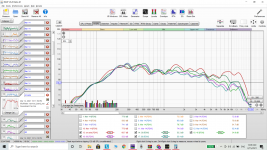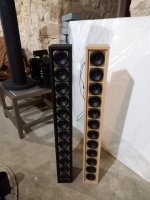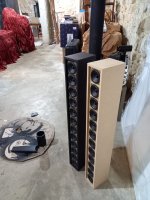The 3dB loss per doubling of distance is due to destructive interference, which varies with both frequency and distance, the "cylindical wedge" is a marketing ploy that does not really exist in practice.the idea behind a longer array than 7ft is to increase the nearfield span of the array, it should fire in a cylindrical way and prevent vertical dispersion and keep a 3db loss by doubling the distance instead of 6db
are you suggesting that this wouldn't work in practice?
Line Array Limitations
will give you a good start to what really works in practice.
Systems with isophasic high frequency sections like the Paraline devices in the DSL SBH20 linked in post #4 or "most PA systems" depicted in #5 behave better than simple multiple driver line arrays as far as what is required for uniform coverage and output level with distance.
Art
The DSL would get my vote. Even though the idea is an array that covers 100 Hz to 6 KHz, I do have doubts it will do what you want it to do(*). It is quite a different task from what we do with the full range array in a living room.
I wouldn't commit to such a task without knowing I could accomplish it. Which isn't today 😉. Copying smart solutions that are made for this job would be a more save approach. Like those JBL CBT arrays. If you have enough information to go on. You'd need to build prototypes, test it, learn from it and adjust.
(*)= meaning the demands may change once you'd have it up and running according to the specs you've set right now.
I wouldn't commit to such a task without knowing I could accomplish it. Which isn't today 😉. Copying smart solutions that are made for this job would be a more save approach. Like those JBL CBT arrays. If you have enough information to go on. You'd need to build prototypes, test it, learn from it and adjust.
(*)= meaning the demands may change once you'd have it up and running according to the specs you've set right now.
Last edited:
the idea behind a longer array than 7ft is to increase the nearfield span of the array, it should fire in a cylindrical way and prevent vertical dispersion and keep a 3db loss by doubling the distance instead of 6db
are you suggesting that this wouldn't work in practice?
Not suggesting that wouldn't work per se it's just that your proposed orientation of the array will put a lot of energy on the hard surfaces creating reverb... the exact opposite of what you want.
Only of the array is pointed at them.Putting the listeners in the nearfield of a speaker should lesser the room effect and make them listen to the speakers instead..
Yes I understand, these buildings are beautiful and nobody wants to cover them up.Room treatment is not an option since ALL the cathedral walls and ceilings are covered in an artistic mosaic
These are pictures I found online but look at the suggested array orientation, the speakers are always pointed at the listeners


Last edited:
Griffin's paper is what i based my research on basically, thank you all for your valuable opinions, i'm getting a couple dozens of drivers and will start building a few prototypes, starting with a simple straight array ,do some measurements and test them in reverberant conditions, if that doesn't do it well i'll start working on shading the arrays, or build a waveguide on a straight array, i did order a few lepai 2020ti amps, pretty good amps and a a dayton audio dsp 408, if delays and power tapering are needed, i'll try that the active way and go from there,
i'll attach some pictures here for the results!
i'll attach some pictures here for the results!
so i've bought 24 drivers, 2 dollar cheapos from parts express, 3 inch fullrange drivers, good from about 200 hz till 10 khz,
I built a 2 meter high line array , driving it with a 14 watt lepai amp, applied a HPF and LPF at 200 hz and 12 khz
attached are gated measurements at 1 meter, on axis and off axis responses, 30, 60 and 80 degrees, they measured better than expected, they sound pretty good too horizontally,
vertically there's an instant 10 db drop and it drops even more when increasing the vertical angle, which is expected and needed.
i;ll also attach pictures of the arrays, and a small video that i took using my phone microphone, did a decent job capturing the sound
they did a pretty good job maintaining an almost constant spl up to 10 meters,
can't hear any comb filtering , tried playing pink noise from 300 hz till 5 khz and using RTA with a microphone going up and down from 1 meter away, expecting to see destructive interferences, nothing showed up on my RTA,
seeing the good horizontal coverage and the absence of audible interferences makes me wonder if any shading is needed at all in my situation, am i missing something?
And what do you guys think about the measurements, arrays and the video?
PS no EQ whatsover, only HPF and LPF
I built a 2 meter high line array , driving it with a 14 watt lepai amp, applied a HPF and LPF at 200 hz and 12 khz
attached are gated measurements at 1 meter, on axis and off axis responses, 30, 60 and 80 degrees, they measured better than expected, they sound pretty good too horizontally,
vertically there's an instant 10 db drop and it drops even more when increasing the vertical angle, which is expected and needed.
i;ll also attach pictures of the arrays, and a small video that i took using my phone microphone, did a decent job capturing the sound
they did a pretty good job maintaining an almost constant spl up to 10 meters,
can't hear any comb filtering , tried playing pink noise from 300 hz till 5 khz and using RTA with a microphone going up and down from 1 meter away, expecting to see destructive interferences, nothing showed up on my RTA,
seeing the good horizontal coverage and the absence of audible interferences makes me wonder if any shading is needed at all in my situation, am i missing something?
And what do you guys think about the measurements, arrays and the video?
PS no EQ whatsover, only HPF and LPF
Attachments
Last edited:
Cool huh? 🙂 Great to see your 2 meter tall prototype.
If you want to shade or not depends on your own needs/wants with regards of quality.
It would be possible to get an even more well behaving vertical beam. Cute video, can't say I recognize the song 😉.
Arrays are fun, and pretty amazing for their floor size.
Like I said earlier (I think in a PM?) if you could use an array like this up front, and after it falls off, repeat it with another (same height) array, properly delayed to make it seamless with the first array this might work, depending on the size you need to cover.
Did you try it inside the church yet? Good work so far.
If you want to shade or not depends on your own needs/wants with regards of quality.
It would be possible to get an even more well behaving vertical beam. Cute video, can't say I recognize the song 😉.
Arrays are fun, and pretty amazing for their floor size.
Like I said earlier (I think in a PM?) if you could use an array like this up front, and after it falls off, repeat it with another (same height) array, properly delayed to make it seamless with the first array this might work, depending on the size you need to cover.
Did you try it inside the church yet? Good work so far.
The song is arabic, trying to test to clarity mainly, i'll test a nearby church tomorrow, not the bigger one though, question, wondering if the cheap drivers might affect quality/clarity of the speakers, assuming low THD I suppose they shouldn't?
The measurements and good horizontal dispersion made me thing that it s unnecessary to use smaller woofers
Say i build 14 of the 2 meter arrays and distribute them everywhere , each array will cover 5 meters of audience, to.ensure speech intelligibility in such a difficult place,
I'm not really sure why delay is needed here,
since each array is going to cover a few rows only
Thanks wesayso!
The measurements and good horizontal dispersion made me thing that it s unnecessary to use smaller woofers
Say i build 14 of the 2 meter arrays and distribute them everywhere , each array will cover 5 meters of audience, to.ensure speech intelligibility in such a difficult place,
I'm not really sure why delay is needed here,
since each array is going to cover a few rows only
Thanks wesayso!
Hi, you need the delay to 'mimic' the path the 'original' source have to do to reach listener ( located far away).
Otherwise their will be a 'lag' wrt what you see/hear.
How to Set Up a Delayed speaker in a Nightclub - Live Sound System Fill Speakers - YouTube
Otherwise their will be a 'lag' wrt what you see/hear.
How to Set Up a Delayed speaker in a Nightclub - Live Sound System Fill Speakers - YouTube
Last edited:
Far away from the closest speaker?
If the arrays are distributed in a way that they're the same distance from all the groups, would delay be needed there?
If the arrays are distributed in a way that they're the same distance from all the groups, would delay be needed there?
If the 'groups' are organised over half a circle ( and on a single row) it may not be needed but as soon as a group is located behind an other ( multiple row in line) you'll gain from a delayed signal.
Take a look at the yt video, it is explained ( and demoed).
Take a look at the yt video, it is explained ( and demoed).
Last edited:
I'm glad if i can help ( but you are already in good company here).
Edit: once correctly set up (with delay and level) you may have reaction from the audience like 'why are the loudspeakers off?'. This is a sign you have managed it right. 😉
Only clue ( visual) you could have could be from videoprojection ( if you have) where you could see lips out of sync with sound ( if length/depth to cover is long enough to introduce more than 5ms delay).
You can experience that in big festivals where there is a second soundsystem set up over the 'mixing booth' to cover the farthest location behind it.
Edit: once correctly set up (with delay and level) you may have reaction from the audience like 'why are the loudspeakers off?'. This is a sign you have managed it right. 😉
Only clue ( visual) you could have could be from videoprojection ( if you have) where you could see lips out of sync with sound ( if length/depth to cover is long enough to introduce more than 5ms delay).
You can experience that in big festivals where there is a second soundsystem set up over the 'mixing booth' to cover the farthest location behind it.
Last edited:
- Home
- Loudspeakers
- Multi-Way
- line array theory in real life?



